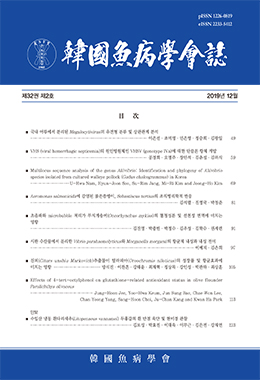흰다리새우는 광범위한 염도(1-40 psu)에서 생존 가능하다. 하지만 염도의 변화, 특히 낮은 염도(1-5 psu)는 생존율, 비특이적 면역능 및 항병능과 같은 다양한 생리적 변화에 영향을 미칠 수 있다. 본 연구에서는 73일 동안 경구 투여 및 사육수 첨가를 동시에 수행한 뒤 성장, 비특이적 면역 및 질병 저항성을 측정하였다. 사육수의 염도는 주기적으로 소금을 첨가하여 3 psu를 유지하였다. 그 결과 73일간 사육 후 생존율이 크게 증가하였으며 (5.6 vs. 15.4%), reactive oxygen species (ROS) 생산과 phenol oxidase (PO) 활성의 유의성있는 증가가 확인되었다. 대조적으로 superoxide dismutase (SOD)활성은 영향을 받지 않았다. 새우에서 Vibrio alginolyticus의 인위 감염 시험의 결과, 프로바이오틱스 처치구에서 약간의 폐사 감소가 관찰되었다 (100 vs. 79%). 결과적으로 저염도(3 psu)에서 양식된 흰다리새우의 생산은 저염도에서 생존가능한 프로바이오틱스에 의해 증가 될 수 있을 것이다.
The whiteleg shrimp Litopenaeus vannamei can survive in a wide range of salinity (1-40 psu). However, such variation, particularly at low salinity (1-5 psu), can affect various physiological changes such as survival rates, non-specific immunity and disease resistance. In this study, growth, non-specific immunity and disease resistance were measured following simultaneous oral feeding and addition of probiotic microbes into culture water for 73 day period. The salinity of the culture water was maintained at 3 psu by periodical salt additions. The result shows that survival rate increased significantly (5.6 vs. 15.4%) after 73 day rearing. Significant increases were identified in reactive oxygen species (ROS) production and phenol oxidase (PO) activity. However, superoxide dismutase (SOD) activity was not influenced. When the shrimp was artificially challenged with Vibrio alginolyticus, slight mortality reduction was observed in the probiotics-treated group (100 vs. 79%). In conclusion, the production of cultured whiteleg shrimp at low salinity might be increased by probiotics survivable at low salinity levels.




